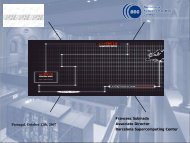e-Infrastructures Roadmap - Internet Society Nederland
e-Infrastructures Roadmap - Internet Society Nederland
e-Infrastructures Roadmap - Internet Society Nederland
- No tags were found...
Create successful ePaper yourself
Turn your PDF publications into a flip-book with our unique Google optimized e-Paper software.
e-<strong>Infrastructures</strong> <strong>Roadmap</strong>Directions to: Collaboration tools and environmentsIf the European Research Area is to take off, serious investments need to be made in order to developand provide better collaboration environments. Whether research communities are working togetherin grid environments or not, sharing information across Europe and beyond will have to be takensignificantly further. In the nineteen seventies the first ideas for groupware as we now call it wereformed in the visionary Plato project, but not much has happened since. Most groupware is still (outof historical grounds) focussed on providing a very basic set of tools for a closed LAN or WAN-environment, although now of course groupware solutions extend their functionality to communicatealso to the outside world. Many of the classical groupware features such as shared storage, calendaring,e-mail/messaging and a forum/discussion area are no longer unique to groupware – and often foundin superior forms on their own. 17 Although a lack of good standards can be blamed for keepingbetter solutions from being developed, the problem until now was probably also that for newconceptual ground to be broken in collaboration environments the networks, the hardware andsoftware were not ready.If we assume the software and hardware now are (or will be within the time frame we are nowlooking at), what modern collaboration tools do we need? We can take e-mail, calendaring, staticfile-sharing, VoIP, wiki’s/web fora and secure instant messaging for granted, although embeddingthese in the user environment would be nice, but otherwise these tools come ‘for free’ with the restof the e-Infrastructure. First of al we need to share run-time software and interaction data betweenclients: this can be done either through a client-server/p2p model or through transmitting theapplication itself and running it on the local machine(s) while sending update messages between thevarious participants. Bulk data can be provided through the grid. Such a set-up will give us distributedvisualisation (i.e. the possibility to look at different synchronous visualisations of the same or relateddata sets or streams and to simultaneously interact with this data with multiple parties – and shareinformation about this within that interaction). It will also enable complex distributed problemsolving environments. The framework for these should be generic, while the user environment willbe highly application domain specific.Secondly, we need to to share high-grade sensory information, such as medical imagery and rawhigh-resolution video footage. In addition we need to be able to send haptic and tactile informationin order to be able to remotely control (robotic) devices that interact with the remote environment.The world of interactive entertainment has taken a huge lead beyond the scientific world andcommercial application domain in this respect in the last decade, with clans of gamers sharingcomplex interactions involving photo realistic visualisation from multiple perspectives, force feedbackinteraction and voice/visual contact – in virtual worlds made up by millions of simultaneous usersusing nothing more than commodity hardware and software. For scientific uses the demands maybe higher with regards to image quality, demanding better camera’s and projection devices. Also, theinteraction with services through the grid will by its nature be much more diverse. The user interfaceswill ultimately not be determined by their level of technological advancement, but by their usability.Because the human nervous system is so familiar with dealing with three dimensional environments,3D immersion facilities and 3D embedded projectors will start playing an important role as e-Sciencegets more and more complex. With the current surge in 3D-camera’s and 3D projection technologies,the possibilities are increasing still.Of course video conferencing facilities to enable on-line meetings are also important to take care ofthe human factor: trust and mutual understanding are key elements in any collaboration. Face to facemeetings, mediated by virtual means, are an important component.Next turnY Support research and open standards for application sharing and multi-user desktop environmentsin collaboration environments.Y Support research into haptic and tactile interfaces to facilitate remote steering.Y Select a set of suitable test projects that can experiment with advanced 3D camera’s and displays.Y Support projects funded by EU and member states in using and testing collaboration tools underdevelopment.End destinationY A set of open and mature collaboration and remote visualisation tools, compatible with theEuropean Science Grid and available on all important platforms.17 Probably the largest advanced international ICT-based collaborations are the one within the open source domain, such asthe development of the Linux kernel and the Debian developers. These open collaborative communities share manyRelevant policies, organisations, activities:characteristics with the science domain, yet they hardly use tools from the classical groupware solutions. They came intobeing by using what was available to them: generic internet services such as Usenet, e-mail and instant messaging as theirY IETF, Open Group, OGF, W3C, WS-I, ICTSB, VL-e, DG Information <strong>Society</strong> and Media.communication platform, with FTP-servers and web-servers to deal with the distribution of their work. Distributeddevelopment on the lowest level is done through tools such as CVS and Subversion for code and wiki’s for written text.Many people from the academic community contribute to open source projects, and fi nd this toolset to be highly effi cient.50 Of course, these are highly skilled users with a strong ICT profi le; probably the average scientist will need some help ininitially setting up these services.51







